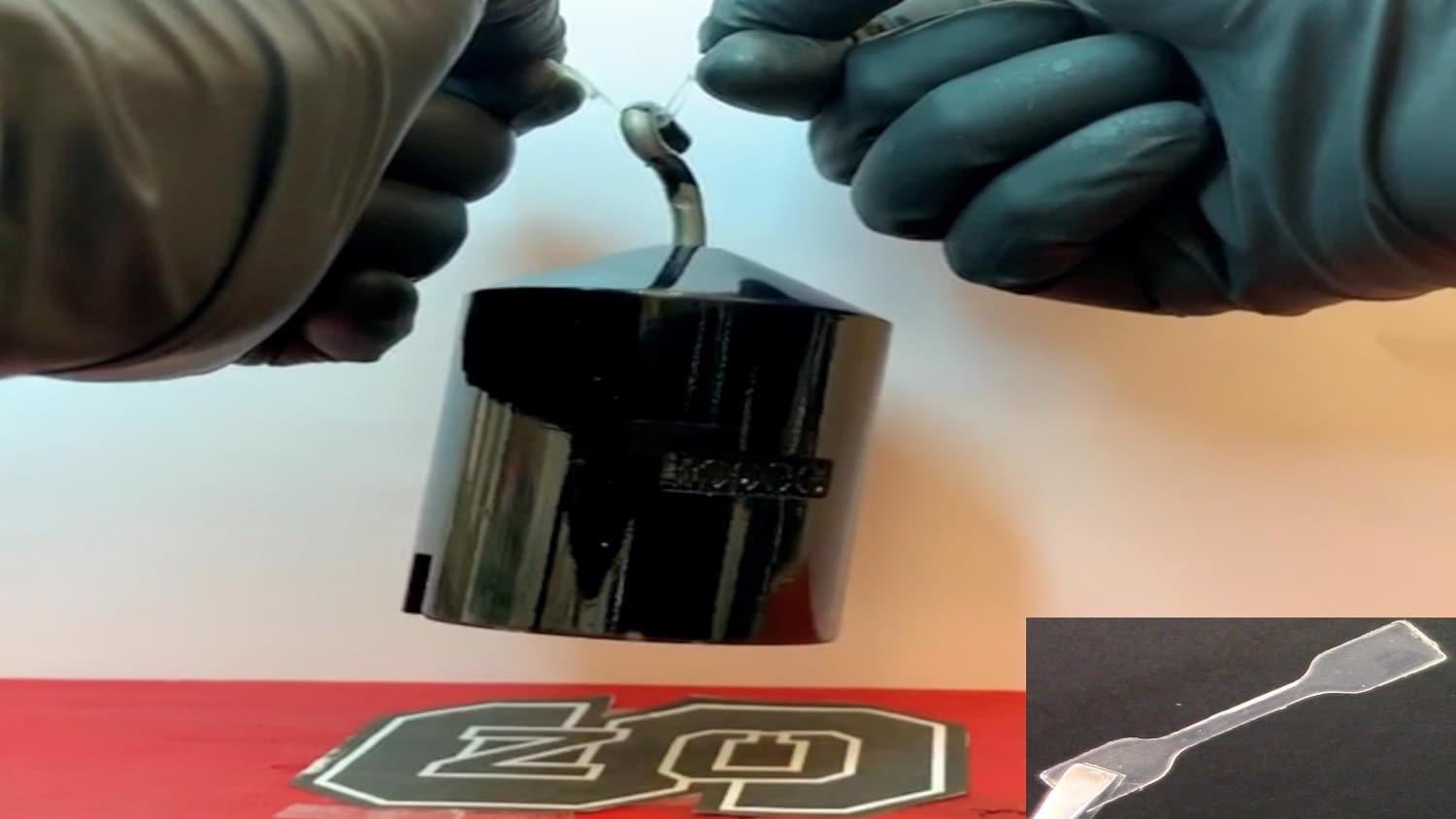Scientists have developed new materials that are extremely stretchable and very tough.

Image Credit: North Carolina State University.
“Materials that can be deformed, but that are difficult to break or tear, are desirable,” says Michael Dickey, the study’s co-corresponding author and the Camille & Henry Dreyfus Professor of Chemical and Biomolecular Engineering at North Carolina State University (NCSU). “Nature is good at this; think of cartilage as an example. But engineering synthetic materials with these properties has been difficult, which makes our work here exciting.”
The new materials belong to the larger class of ionogels, which are polymer networks that comprise salts that are liquid at ambient temperature. These salts are referred to as ionic liquids.
Dickey and his collaborators have created ionogels that are approximately 70% liquid but possess extraordinary mechanical properties. Specifically, they are tough — that is they can dissipate a great amount of energy when they are deformed, rendering them very hard to break. They are also easy to process, easy to produce and can be 3D printed.
Hydrogels, which are polymer networks that contain water, are fairly common. For example, contact lenses are hydrogels. But ionogels have some advantages over hydrogels. Ionic liquids don’t evaporate like water, so you don’t have to worry about the ionogels drying out. Ionogels are also electrically and thermally stable and conduct electricity well, raising some interesting opportunities for future applications.
Michael Dickey, Co-Corresponding Author and Camille and Henry Dreyfus Professor of Chemical and Biomolecular Engineering, NCSU
To develop the new ionogels, the scientists began with monomers of polyacrylamide (used in contact lenses) and polyacrylic acid (used in baby diapers) and copolymerized them in a solution of ionic liquid with the aid of ultraviolet light.
That is to say, they took the constituents for polyacrylic acid and polyacrylamide, positioned them in an ionic liquid, and irradiated light on it to form a copolymer that includes both monomers and the ionic liquid itself.
The end result is significantly better than an average of the two materials. It is like adding 1+1 and getting 10. The resulting gel has the stretchability of polyacrylic acid and is even stronger than the polyacrylamide. In terms of toughness, it’s better than cartilage. But the differences between ionogels and hydrogels make them advantageous for different applications.
Michael Dickey, Co-Corresponding Author and Camille and Henry Dreyfus Professor of Chemical and Biomolecular Engineering, NCSU
Furthermore, the ionogels developed by Dickey’s team also possess self-healing and shape memory features. Two pieces of the ionogel can be stuck together and exposed to heat, and it reforms a robust bond.
In a similar manner, the ionogel can be deformed into a short-term new shape, but it will return to its former shape when in the presence of heat. The amount of heat required is subject to how rapidly the material has to “heal” or return to its original shape. When placed in an area at 60 °C, the actions take only tens of seconds.
We’re excited that we’ve made something with truly remarkable properties that can be made very easily—you just shine light on it—using widely available polymers. And you can tailor the properties of the ionogels by controlling the ratio of ingredients during the copolymerization process.
Michael Dickey, Co-Corresponding Author and Camille and Henry Dreyfus Professor of Chemical and Biomolecular Engineering, NCSU
“We’re already working with one industry partner, and are open to working with others to develop applications for this new breed of ionogels,” Dickey added.
The article was published in the journal Nature Materials. The article’s first author is Meixiang Wang, a postdoctoral researcher at NC State who also has an affiliation with Xi’an Jiaotong University.
The article was co-authored by Mohammad Shamsi, a Ph.D. student at NC State; Jacob Thelen, a collaborator at NC State; Vi Khanh Truong, a visiting scholar at NC State who is affiliated with RMIT University; Jinwoo Ma, a postdoctoral researcher at NC State; Pengyao Zhang and Jian Hu, of Xi’an Jiaotong University; and Wen Qian of the University of Nebraska-Lincoln.
The study was carried out with partial support from the Coastal Studies Institute.
Tough and stretchable ionogels
Video Credit: North Carolina State University
Journal Reference:
Wang, M., et al. (2022) Tough and stretchable ionogels by in situ phase separation. Nature Materials. doi.org/10.1038/s41563-022-01195-4.